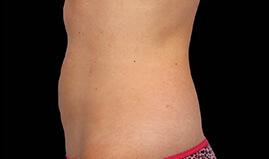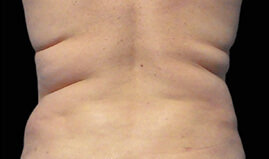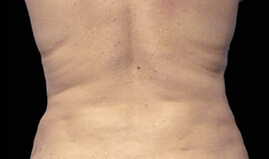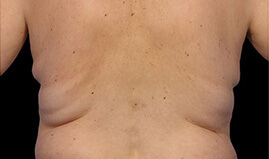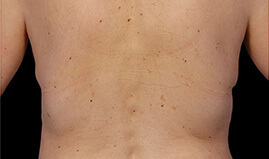Most of us can look in the mirror and find fat we’d rather not be there. Even strict diet and exercise leaves behind some of our most stubborn fat — wherever our bodies want to leave it. It can be quite disheartening to still have love handles after working so hard for so long to slim down.
Many people who want to get rid of these stubborn fat pockets, but just can’t seem to get there are turning to cryolipolysis, oftentimes referred to as CoolSculpting.
Chances are, you’ve heard of it by now. It’s being advertised on television, on the radio, and in podcasts as a more affordable, safer alternative to surgery (with no downtime, to boot).
So… what is it? And what’s the science behind it?
Contents
What Is Cryolipolysis?
Cryolipolysis is the process of freezing fat cells in the body. But you might be more familiar with the term CoolSculpting, which is the most popular brand name of the machine created to perform the procedure.
The basis of cryolipolysis is that subcutaneous fat cells are more sensitive to cold temperatures than other tissue in the body, such as skin or other organs. Therefore, fat cells can be frozen and killed without doing any harm to surrounding tissue.
 During the procedure, a thin film is first placed on the treatment area. Once the area has been prepared, a specially designed applicator attached to a cryolipolysis machine is placed on top of the film. This film has two major functions: to protect the skin from the cold and to help create a better seal between the applicator and the skin.
During the procedure, a thin film is first placed on the treatment area. Once the area has been prepared, a specially designed applicator attached to a cryolipolysis machine is placed on top of the film. This film has two major functions: to protect the skin from the cold and to help create a better seal between the applicator and the skin.
Once the applicator is securely in place, the machine is set and the client is free to do almost whatever he or she would like as long as the treatment area remains relatively still (so the applicator doesn’t dislodge). They can read, use a tablet or phone, get some work done — or even sleep!
In the weeks following the cryolipolysis procedure, the body’s natural processes find the dying fat cells, break them down, and the lymphatic system gets rid of them. Therefore, the visibly noticeable effects of CoolSculpting aren’t immediate. It may take two to three months before the full effects are realized.
While it may be frustrating to wait so long for the results, they’re likely to be worth the wait. CoolSculpting has been proven time and time again to be an effective way to reduce fat in targeted areas of the body. In fact, it’s so effective, it’s the world’s number one fat reduction treatment.
One 2015 review of 16 cryolipolysis studies found that the average fat reduction about four months after the procedure was 19.55 percent. A different review that looked at 19 cryolipolysis studies found similar fat reduction ranges across measurement methods: 14.67 percent to 28.5 percent using calipers and 10.3 percent to 25.5 percent using ultrasound.
One of the best things about CoolSculpting (aside from your clothes fitting better) is that there’s literally no down time after the procedure, unlike with surgical fat reduction treatments.
Clients can leave the office and head to work, go out to dinner with friends, or even hit the gym. In addition, the possible side effects are minimal — soreness, redness, and swelling in the treatment area — and major complications are few and far between.
Is CoolSculpting at Home or DIY Cryolipolysis Possible?
While the cryolipolysis process — cooling subcutaneous fat until it freezes and dies — is remarkably simple, DIY CoolSculpting isn’t something you should try at home.
CoolSculpting machines and applicators are designed very specifically to protect the skin while freezing the fat cells. Putting a bag of frozen veggies on your thighs to prepare for bikini season will not only be disappointing (in that it won’t work), but you may also do serious damage to your skin.
 One study published by the Journal of the American Medical Association (JAMA) in 2013 described cold-induced dermatitis caused by prolonged exposure to ice packs used to treat chronic pain in two different clients. You can even get frostbite by leaving something frozen on your skin for too long.
One study published by the Journal of the American Medical Association (JAMA) in 2013 described cold-induced dermatitis caused by prolonged exposure to ice packs used to treat chronic pain in two different clients. You can even get frostbite by leaving something frozen on your skin for too long.
In addition, CoolSculpting machines are very precise in their temperature regulation and have been tested again and again to produce minimal side effects and gain FDA approval. Freezers don’t necessarily keep the same temperature very well, nor are they subject to the same regulations that a CoolSculpting machine would be.
While finding a DIY cryolipolysis solution might sound like a good idea, it could potentially do more harm than good. It’s best to leave the fat freezing to trained professionals.
Who Discovered Cryolipolysis?
The foundation for cryolipolysis can be traced all the way back to 1902 when Austrian physician Carl Hochsinger noted plaques in the submental region (the area between the face and neck) of children after exposure to cold. In 1941, H. Haxthausen noted something similar in the cheeks of children in the days following exposure to cold. He called it adiponecrosis e frigore.
In 1963, cold panniculitis was reported in a young woman — much older than in previously reported clients, which had been toddlers or infants. Upon further testing, researchers were even able to replicate the effect using ice cubes.
In 1966, more extensive research was done with a 6-month-old to determine how cold affected the junction of the dermal and subdermal layers over time. Upon duplicating the effect, they observed the area 30 minutes after exposure, then after 6 hours, 24 hours, 48 hours, 72 hours, 6 days and finally, two weeks. They found that harder plaques were formed around the 48 or 72-hour mark, but that the effects weren’t lasting.
From there, Doctors Ervin H. Epstein, Jr. and Mark E. Oren published a paper in 1970 regarding a condition they called popsicle panniculitis because they were able to recreate an effect similar to cold panniculitis by having children suck on popsicles. Red blotches appeared on the children’s cheeks in the hours following consumption.
But the most important part of this research was that some the fat cells exposed to the cold actually died, leaving an indentation in their wake — a sweet little dimple.
For the next three decades, similar research was conducted, particularly in adults, as children are so much more susceptible to the condition (given that their saturated to unsaturated fat ratio is greater). But in the late 2000’s, Harvard University scientists Dieter Manstein, MD, PhD, and R. Rox Anderson, MD picked back up on it, wondering if there was more to be explored.
They conducted research and experimented to see if they could replicate popsicle panniculitis — but more importantly, the breakdown of subcutaneous fat cells — in adults. If fat could be frozen and destroyed in the cheeks, could this effect be replicated on other parts of the body?
They were successful, starting a fat freezing revolution.
In the past 10 years, CoolSculpting has gained FDA clearance for multiple treatment areas, including the abdomen, flanks, thighs, back, the area at the bottom of the buttocks, the upper arm, and most recently, the double chin. And at the rate they’re going, they’ll have clearance for additional treatment areas before too long.
R. Rox Anderson: A Modern Benjamin Franklin
Dr. Anderson’s full name is Richard Rox Anderson, but his colleagues and the people who know him best simply call him Rox. While it’s true he helped create the cryolipolysis procedure, that’s not the only innovation he’s had a heavy hand in.
In fact, his work is so far-reaching that he holds a few dozen patents (more than 60, both nationally and internationally-held, according to his official bio) and has co-authored more than 250 scientific pieces, including books and papers.
It’s no doubt that Anderson’s work is prolific, but he took a roundabout way of getting to where he is. He initially began his studies in physics and electrical engineering at the Massachusetts Institute of Technology (MIT).
He spent some time teaching and working odd jobs to make ends meet, and eventually ended up at Massachusetts General Hospital as a technician. There, he worked with dermatologists who were trying to use ultraviolet light as a means of treating psoriasis.
This experience led him to medical school, where he continued to explore and study dermatology and the use of lasers to correct skin abnormalities.
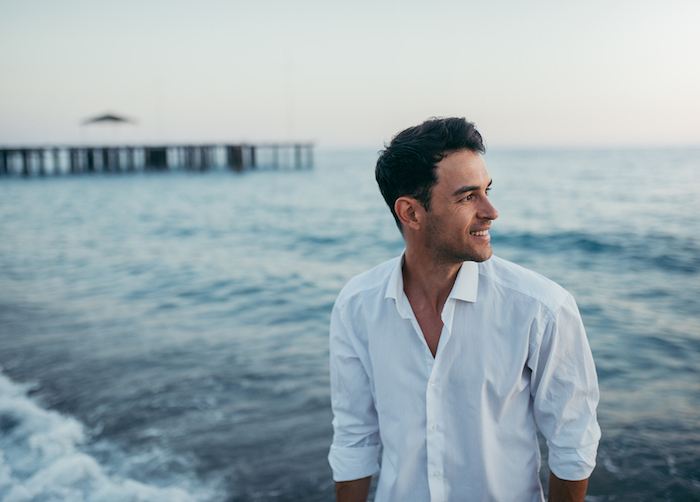
According to John Parrish, one of Anderson’s mentors in the joint MIT-Harvard medical school program, “[Anderson] thought that by using lasers of a certain wavelength, you could heat up the abnormal blood vessel,” like the ones that create birthmarks, for example, and destroy them — but in a way that didn’t result in scarring.
However, such a laser didn’t exist, so he discussed his idea with a fellow researcher who was building lasers — and as Parrish says, “it worked — it got rid of the hemangiomas [a collection of blood cells] without any scarring.”
Anderson has continued to work with lasers throughout his career, using them to focus mostly on skin conditions present in children and adolescents. George Cotsarelis, a dermatology professor at the University of Pennsylvania, says Rox Anderson “developed virtually every laser used by dermatologists in their clinic.” Cotsarelis even calls him a “modern-day Benjamin Franklin.“
Anderson is at a point in his life when most people retire, but he doesn’t seem to be anywhere near that milestone. Even today — four decades into his career — he still sees clients at MassGeneral Hospital for Children, in addition to frequently operating at Shriner’s Hospital so he can serve less fortunate children and make sure they receive necessary medical treatments. And of course, he’s still conducting research.
In the past, Anderson developed a laser to help heal particularly bad flesh wounds, but is now working on a replacement for skin grafts, which typically result in a scar on the area from which the skin was taken.
SevenOaks BioSystems has developed quite a few devices based on Anderson’s research and is currently working on a device that collects “microcolumns” of skin, from the surface, down multiple layers of subcutaneous fat, and then places them over wounds, where skin is able to regrow on its own.
Anderson is also working to find a combination of a drug and a device that will stimulate new hair growth in new hair follicles for a company called Follica, which Anderson founded with George Cotsarelis.
The thought process is that “Following skin disruption, cells that migrate to help healing are forced to make a decision: Should I make epidermis, or should I make a hair? There is a window of opportunity in which we can potentially push them to choose the latter.”
But of all Anderson’s inventions, patents, and innovations, CoolSculpting is certainly one of the most lucrative — and definitely the most popular. Anderson understands that the way we look plays into our self-esteem and self-image and actively finds ways to make us feel better about ourselves. It’s fair to say that millions of people have benefited from his work, and that number will only continue to grow.
Is Cryolipolysis Right For Me?
CoolSculpting isn’t right for everyone. It’s best suited for candidates with soft fat pockets on the body, like love handles, a double chin, upper arm fat, or abdominal fat. Cryolipolysis doesn’t work well with harder fat deposits — the best type of fat for this procedure can be pulled away from the body or pinched.
In addition, CoolSculpting should be only one part of your strategy to reduce fat on your body. Cryolipolysis cannot and will not eliminate fat in the treatment area, but rather reduce it.
It’s true that cryolipolysis kills fat cells, but it doesn’t prevent your remaining fat cells from expanding and essentially undoing what CoolSculpting did for you. Good candidates for this procedure are still committed to living a healthy lifestyle complete with a balanced diet and regular exercise.
At DaVinci Body Sculpting, CoolSculpting is all we do. It’s our mission to provide the best CoolSculpting experience possible for all our clients. We want to help you achieve your goals — whatever they may be. Give us a call today to take the first step toward the body you’ve always dreamed of

